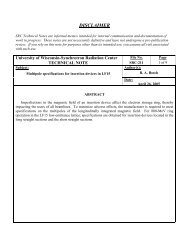SRC Users' Meeting - Synchrotron Radiation Center - University of ...
SRC Users' Meeting - Synchrotron Radiation Center - University of ...
SRC Users' Meeting - Synchrotron Radiation Center - University of ...
You also want an ePaper? Increase the reach of your titles
YUMPU automatically turns print PDFs into web optimized ePapers that Google loves.
THE INITIAL AND FINAL STATE BANDS<br />
IN BI ALONG T<br />
Christian R. Ast 1,2 and Hartmut Höchst 1<br />
1 <strong>Synchrotron</strong> <strong>Radiation</strong> <strong>Center</strong>, <strong>University</strong> <strong>of</strong> Wisconsin-Madison, Stoughton, WI 53589<br />
2 Max-Planck-Institut für Festkörperforschung, Stuttgart, Germany<br />
Determining the dispersion <strong>of</strong> an energy band in three dimensional momentum space<br />
from angle resolved photoemission spectra requires knowledge <strong>of</strong> the final state band structure<br />
since information about the momentum <strong>of</strong> the photoelectron is lost as it is refracted at the sample<br />
surface. Commonly, a free electron final state model is assumed, however, at low final state<br />
energies the bands can still be affected by the periodic potential such that the free electron model<br />
breaks down. It has been shown from normal emission spectra <strong>of</strong> Bi(111) that for final state<br />
energies below about 60 eV deviations from the free electron approximation can be observed [1].<br />
In order to find the band dispersion in momentum space from photoemission spectra involving<br />
low final state energies both initial and final state bands have to be extracted from the<br />
photoemission spectra.<br />
Fig. 1: Normal emission spectra <strong>of</strong> Bi(111) as a function <strong>of</strong> photon energy.<br />
We report angle resolved photoemission spectra <strong>of</strong> Bi(111) measured at normal emission<br />
as a function <strong>of</strong> photon energy. Changing the photon energy in this geometry samples the<br />
Brillouin zone along the T line. The photon energy range extends from 8 eV to 100 eV<br />
covering several Brillouin zones. From the data we have extracted the initial state bands within 3<br />
eV binding energy as well as the final state bands up to a final state energy <strong>of</strong> 100 eV using a<br />
phenomenological, modified free electron model that incorporates deviations from the freeelectron<br />
dispersion. In Fig. 1 a close up <strong>of</strong> the photoemission spectra can be seen for one <strong>of</strong> the<br />
bulk bands in Bi. The solid and dashed lines trace primary and secondary cone emission features<br />
while the circles indicate peak positions in the spectra. The arrows labeled G1 to G3 indicate<br />
final state gaps away from the Brillouin zone boundaries which are visible in the photoemission<br />
spectra.
















